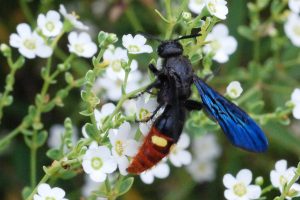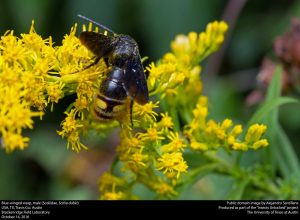
Are you dubious about your feelings on wasps? Then you should meet the Blue-Winged Wasp, Scolia dubia!. A fear of wasps is common, but if you see the Blue-Winged Wasp in your garden, don’t be alarmed! These insects won’t sting you if they’re not threatened, and they’re actually beneficial to your garden. For example, you know those June Beetles and Japanese Beetles that ravage your vegetables? The Blue-Winged Wasp is a predator of those! The Blue-Winged Wasp is one of the most common “solitary” wasps. Other than mating, it doesn’t interact with other wasps, which makes it very different from the yellow jackets or hornets that often interfere with picnics. This wasp is fairly large, about the size of a quarter! It is easily identifiable because of its two-colored abdomen: black on the top and reddish orange on the bottom. On the reddish orange part of the abdomen, there are two bright yellow spots close to the waist. It earned its name because when the sun shines on its black wings, there is a blue sheen.
The Blue-Winged Wasp is a widespread species found throughout the country, including Pennsylvania! They are parasites of scarab beetle grubs, specifically June Beetles and Japanese Beetles. The female wasp flies low over the surface of the soil and somehow knows where the beetle grubs are underground.
Is it magic? This video would make it seem so, but who knows, we haven’t seen any research about how exactly they find their targets. When she detects a beetle grub, she lands on the soil and starts digging. They have insanely strong legs that are very spiny. When a scarab grub gets exposed, it will make an attempt to rebury itself immediately. The wasp will sting the grub to paralyze it. Then she digs a hole and drags the paralyzed grub into the hole, and lays an egg on top of the grub. She seals up the hole, and repeats this process. Other than ensuring her egg is laid on a tasty grub, the female Blue-Winged Wasp doesn’t provide further motherly care . Not surprisingly, males don’t provide parental care at all! Once the wasp larva hatches, it feeds on the grub while it’s still alive. It will feed on the beetle grub for about a week before making a cocoon for itself. It will emerge from its cocoon the following summer as an adult wasp. These wasps only live for one season, so approximately four to five months.
Male and female Blue-Winged Wasps commonly visit flowers (e.g. Goldenrod and Mountain Mint) to feed on nectar during the day. Males have longer antennae and a skinnier physique than the females. In the morning, the males fly near the ground in an unique pattern, hoping to find and mate with a virgin female just emerging from the ground. Males also have a distinctive prong-like “pseudostinger” that is used in copulation… compensating for something? Males cannot sting, and females do not sting humans, so no worries!
Sleight of Wings Did you know that insects cannot actually produce a blue pigment? While the animal kingdom has mastered how to make almost any pigment, virtually no animal can actually produce the color blue! So, how does the Blue-Winged Wasp have its eponymous name? It’s all a trick of light. At certain angles, the light hits the wings of the Blue-Winged Wasp, tricking the eye into thinking that the wings are blue.
Should I be scared? Unless you’re a scarab beetle grub, there’s no reason to be scared of this wasp. Although these wasps look scary, they are harmless and rarely sting people (unless the wasp feels threatened and is forced to sting in self defense). But why would you threaten a wasp in the first place? Pick on someone your own size!

The birds and the wasps. Both males and females engage in mating dances, which consists of doing the Macarena. Just kidding, they fly close to the ground in figure eight patterns, which is probably more exciting to them than one hundred macarenas. There is little information known about their mating rituals. The Blue-Winged Wasp breeds once a year between April and November, depending on the location. The Blue-Winged Wasp contributes significantly to controlling lawn grub populations, as well as helping the bees out with pollination of wild flowers. The Blue-Winged Wasp is a parasitoid species, which means that not only does it get its nutrients from a host victim, but it kills the host in the process. A female lays one egg per grub, and she lays more than one egg per season, making this wasp an excellent biological control of the beetles that eat your home garden! If you want to encourage these beneficial wasps to visit your garden, make sure to plant Goldenrod – the Blue-Winged Wasp seems to like the taste of the Goldenrod nectar!
Nice post! You have written useful and practical information. Take a look at my web blog 81N I’m sure you’ll find supplementry information about Thai-Massage you can gain new insights from.